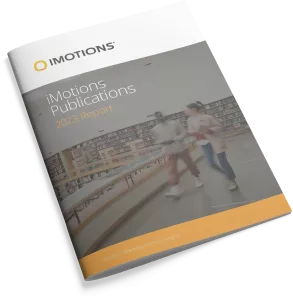-
Transdermal neuromodulation of noradrenergic activity suppresses psychophysiological and biochemical stress responses in humans
Abstract: We engineered a transdermal neuromodulation approach that targets peripheral (cranial and spinal) nerves and utilizes their afferent pathways as signaling conduits to influence brain function. We investigated the effects of this transdermal electrical neurosignaling (TEN) method on sympathetic physiology under different experimental conditions. The TEN method involved delivering high-frequency pulsed electrical currents to ophthalmic […]
-
Timing of Unstructured Transitions of Control in Automated Driving
Abstract: With automated driving systems, drivers may still be expected to resume full control of the vehicle. While structured transitions where drivers are given warning are desirable, it is critical to benchmark how drivers perform when transition of control is unstructured and occurs without advanced warning. In this study, we observed how participants (N=27) in […]
-
Dynamic Data Driven Operator Error Early Warning System
Abstract: Mitigating human errors is a priority in the design of complex systems, especially through the use of body area networks. This paper describes early developments of a dynamic data driven platform to predict operator error and trigger appropriate intervention before the error happens. Using a two-stage process, data was collected using several sensors (e.g. […]
-
Differences in eye-tracking measures between visits and revisits to relevant and irrelevant Web pages
Abstract: This short paper presents initial results from a project, in which we investigated differences in how users view relevant and irrelevant Web pages on their visits and revisits. The users’ viewing of Web pages was characterized by eye-tracking measures, with a particular attention paid to changes in pupil size. The data was collected in […]
-
Understanding The Utilization Of Information Stimuli in Design Decision Making Using Eye Gaze Data
Abstract: Research on decision making in engineering design has focused primarily on how to make decisions using normative models given certain information. However, there exists a research gap on how diverse information stimuli are combined by designers in decision making. In this paper, we address the following question: how do designers weigh different information stimuli to […]
-
Products Shared Visual Features Do Not Cancel in Consumer Decisions
Abstract: Consumers’ product purchase decisions typically involve comparing competing products’ visual features and functional attributes. Companies strive for “product differentiation” [1-5], which makes consumers’ product comparisons fruitful but also sometimes challenging. Psychologists that study decision-making have created models of choice such as the cancellation-and-focus (C&F) model. C & Fexplains and predicts how people decide between choice […]
-
Suppression of human psychophysiological and biochemical stress responses using high-frequency pulse-modulated transdermal electrical neurosignaling
Abstract: We have developed a neuromodulation approach that targets peripheral nerves and utilizes their afferents as signaling conduits to influence brain function. We investigated the effects of this transdermal electrical neurosignaling (TEN) approach on physiological responses to acute stress induction. TEN was targeted to the ophthalmic and maxillary divisions of the right trigeminal nerve and […]
-
Dynamic Data Driven Approach for Modeling Human Error
Abstract: Mitigating human errors is a priority in the design of complex systems, especially through the use of body area networks. This paper describes early developments of a dynamic data driven platform to predict operator error and trigger appropriate intervention before the error happens. Using a two-stage process, data was collected using several sensors (e.g., […]
-
Towards Inferring Web Page Relevance – An Eye-Tracking Study
Abstract: We present initial results from a project, in which we examined feasibility of inferring web page relevance from eye-tracking data. We conduced a controlled, lab-based Web search experiment, in which participants conducted assigned information search tasks on Wikipedia. We performed analyses of variance as well as employed classification algorithms in order to predict user […]
-
Automatic Detection of Learning-Centered Affective States in the Wild
Abstract: Affect detection is a key component in developing intelligent educational interfaces that are capable of responding to the affective needs of students. In this paper, computer vision and machine learning techniques were used to detect students’ affect as they used an educational game designed to teach fundamental principles of Newtonian physics. Data were collected […]
Research Report 2023
In-depth look at the scientific landscape as powered by iMotions software, showcasing groundbreaking research and the impact of our tools in various scientific and industrial fields.

Share Your Research

850+ universities worldwide with an iMotions human behavior lab
73 of the top 100 highest ranked universities
710+ published research papers using iMotions
iMotions is used for some of the most interesting human behavior research studies carried out by top researchers around the world. Contact us to have your publication featured here.
The authors of these publications have used iMotions as a software tool within their research.
“Software should be cited on the same basis as any other research product such as a paper or a book; that is, authors should cite the appropriate set of software products just as they cite the appropriate set of papers” (Katz et al., 2020).
We therefore encourage you to cite the use of iMotions where appropriate.
How to cite iMotions
APA
iMotions (10), iMotions A/S, Copenhagen, Denmark, (2024).
Note: adjust the version and year where relevant.
5 Most Popular Blogs
Learn How to Conduct Human Behavior Research with iMotions
Publications
Read publications made possible with iMotions
Blog
Get inspired and learn more from our expert content writers
Newsletter
A monthly close up of latest product and research news





